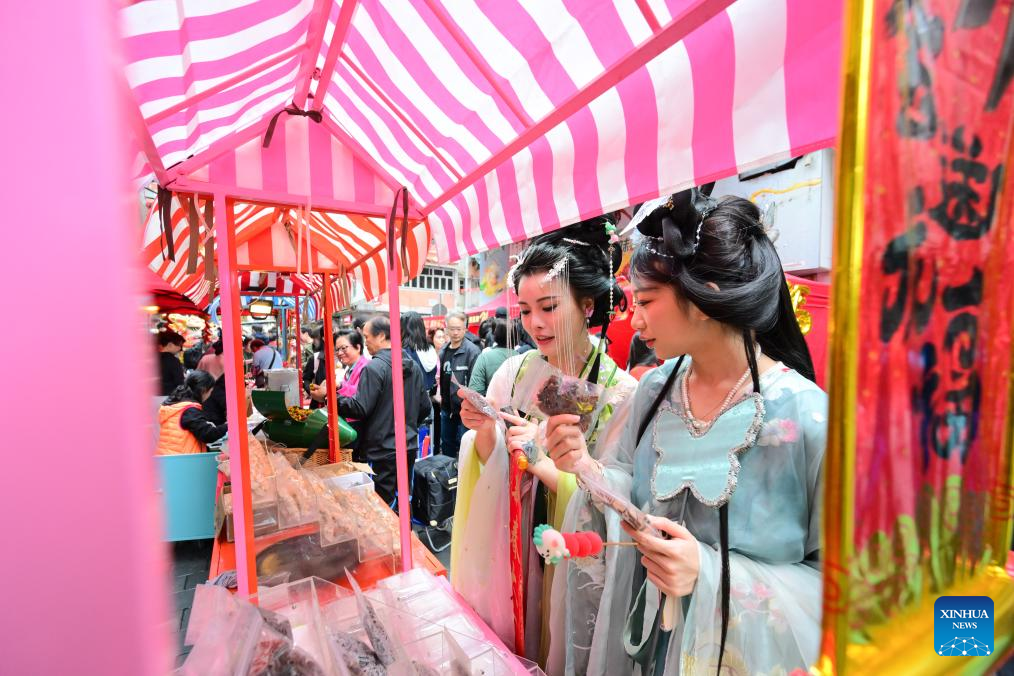New Chinese-style fashion fuels consumption growth
From:People's Daily OnlineAuthor: 2024-02-28 14:04
The popularity of Hanfu, the traditional clothing of China's Han ethnic group, is surging both domestically and globally.
Yang Jie, a professor at the Beijing Institute of Fashion Technology, noted that the designs, patterns, and combinations of Hanfu are evolving to be more aesthetically appealing and comfortable, fueling increasing consumer demand.
As Beijing experienced its first snowfall of the Year of the Loong on Feb. 21, many visitors to the Temple of Heaven wore traditional Hanfu attire. Men sported round-collared robes, and women wore long gowns with sleeves resembling the pipa, a traditional pear-shaped stringed musical instrument. Some children were seen in Ming-style hats, drawing looks from passersby.

Visitors in Hanfu costumes, a style of clothing traditionally worn by the Han people, select snacks during an event celebrating the upcoming Chinese New Year at the Temple Street in south China's Hong Kong, Feb. 4, 2024. (Xinhua/Zhu Wei)
"If you're looking to have makeup and hairstyling done, you'll need to wait until the Lantern Festival," said Li, a woman who owns a Hanfu experience store near Dashilan commercial street in Beijing's Qianmen area. Li typically provides makeup and hairstyling services to eight or nine customers every day.
According to Li, there has been a noticeable increase in visitors who bring their own Hanfu for makeup and hairstyling. They no longer just rent outfits from the store but come with their own distinct personal styles and preferences.
The makeup and hairstyling sector is thriving, with Hanfu demand remaining strong beyond the Spring Festival. A notable trend is the popularity of the horse-faced skirt, known as mamianqun in Chinese, which has become a popular bestseller.
On Feb. 22, a store on Pinduoduo, a popular e-commerce app in China, sold over 26,000 Ming-style horse-faced skirts. The store's monthly sales of mamianqun topped 3 million yuan ($416,700).
Caoxian county in east China's Shandong Province is the country's largest production base for Hanfu. During the Spring Festival holiday, its sales of Chinese New Year clothes including horse-faced skirts exceeded 300 million yuan.
Throughout the holiday, Hanfu enthusiasts from around the world were a trending topic of discussion. According to Xiaohongshu, China's lifestyle-focused social media platform, over 10,000 social media influencers donned Hanfu to celebrate the Chinese New Year overseas, boosting the popularity of traditional Chinese clothing in countries and regions such as the U.K., the Netherlands, and Spain.
The trend of wearing Hanfu has expanded globally, resulting in higher sales on international e-commerce platforms.
"Temu has launched a Hanfu category in Australia, featuring horse-faced skirts priced between 35 and 50 Australian dollars ($33)," said a Melbourne resident surnamed Hu. Temu is a cross-border e-commerce launched by Pinduoduo.
The growing demand for horse-faced skirts has spurred the transformation of traditional foreign trade home textile companies.
Xucun township in east China's Zhejiang Province is one of the largest jacquard fabric production bases in the country. A local factory there, specializing in jacquard fabric, has been operating nonstop, with 24 large jacquard machines producing horse-faced skirt fabric around the clock.
"Six months ago, our primary products were curtain and sofa fabrics," said Zhang Yongming, the company's head.
In the past, the company exported 80 percent of its home textile products to the Middle East and Africa. However, sales in those regions notably declined. Fortunately, new business opportunities have emerged with orders for horse-faced skirt fabric, opening new possibilities for the company.
New Chinese-style fashion has emerged as one of the most prominent trends on social media. According to data from Vipshop, a major online discount retailer in China, sales of new Chinese-style clothing doubled in the month before and after the Spring Festival compared to January 2023.
"With a sense of cultural confidence, the trend of new Chinese-style fashion will continue to gain momentum," Yang expressed.
Edit:董丽娜
The copyright of the article and the picture belongs to the original author. If there is any infringement, please contact to delete it